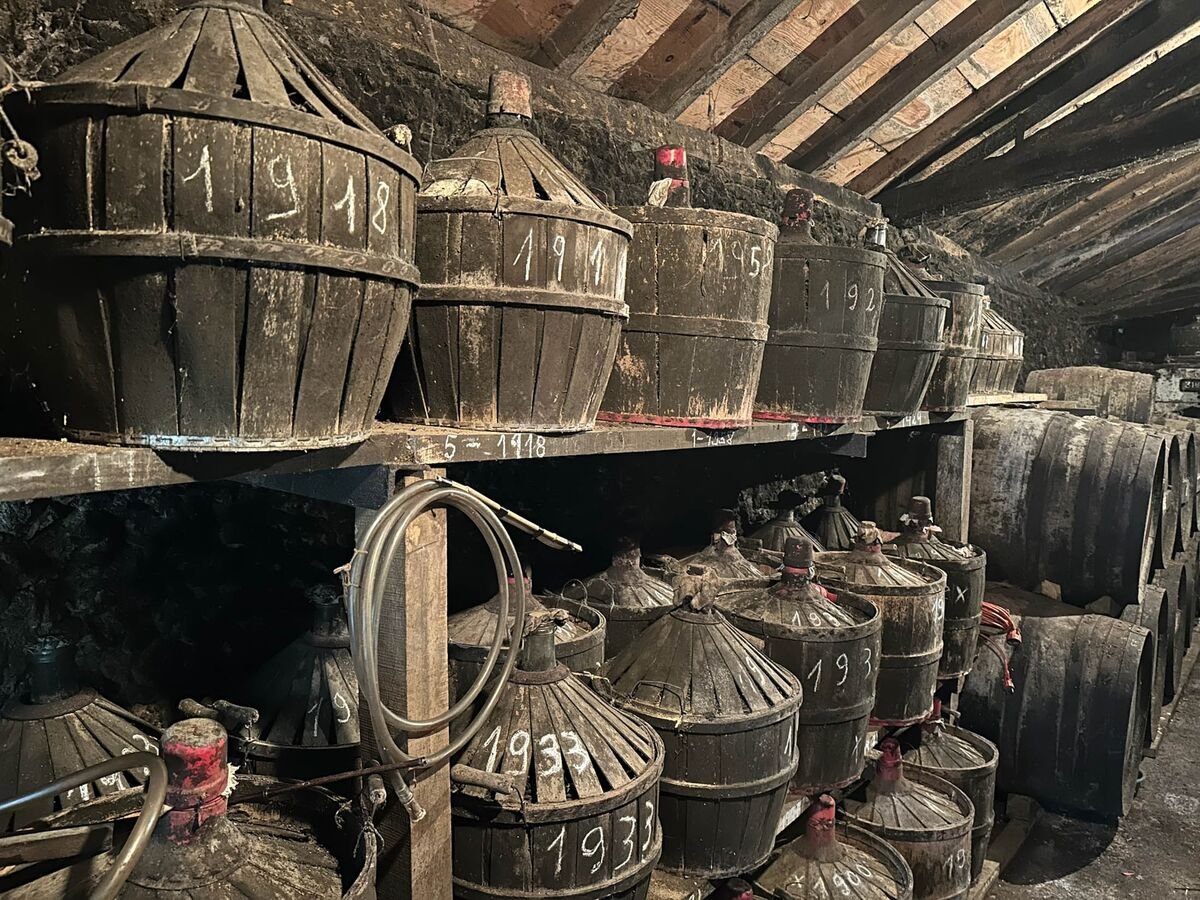Illustration by Nico H. Brausch
By Christopher Ross
June 18, 2024 at 6:27 AM UTC
Bourbon collectors, I feel your pain. What was once a niche hobby for booze geeks has become a forbiddingly expensive and competitive endeavor, what with the annual Pappy Van Winkle lotteries (and heist) and secondary markets where a $2,000 bottle of 20-year Eagle Rare can leap to $14,000 in just five years.
Still, if you love the hunt for artisanal, rare spirits, have you considered pivoting from grains to grape? The warmth and woodsy flavors of single-barrel, full-strength cognac and Armagnac can closely resemble the taste of bourbon, at a more attainable price point.
“Folks who’ve had the opportunity to taste these bottles notice, wow, there’s that concentration, that similar profile of combining fruit and structure from the wood,” says Greg Faron, co-founder of new importer Bien Élevé in Washington, DC. Some vintage brandy can compare in flavor to glut-era bourbon, he says, referring to the 1970s-to-early-’90s period when distillers cleared out older, languishing whiskey stock under younger labels.
Bien Élevé joins established importers PM Spirits and Charles Neal Selections—plus upstarts such as Bhakta Spirits, from the founder of WhistlePig whiskey—as part of an expanding network of bottlers and retailers working with aficionados to build a ground floor for collecting these complex liquors.
Their biggest obstacle? The French.
See, when it comes to investment bourbon, what’s most sought-after are single-vintage bottles, ideally single-barrel, bottled at cask strength—offering a premium of intensity and purity and rarity, traceable to a specific location and point in time. But that’s exactly the opposite of how French brandy is traditionally produced.
Distillers at major cognac houses such as Hennessy and Courvoisier believe the beauty of their craft lies in artful blending; they lock up eaux-de-vie (unaged spirit distilled from grapes) from hundreds of growers to do so. There are strict brandy-making rules around grape varietals, distillation and minimum aging time in oak barrels, but blending isn’t actually a prerequisite.
“I’m French, so I can say this: The French feel they are the guardians of a tradition, which makes them not innovate whatsoever,” says PM Spirits founder Nicolas Palazzi, one of the first importers to bring unblended, collector-bait brandy to the US.
The Cognac region, Palazzi says, is particularly disincentivized to put out the kind of artisanal spirits that US buyers are clamoring for. If a producer decides to set aside a barrel for aging as a vintage cognac, a member of the Bureau National Interprofessionnel du Cognac (BNIC) must be present for its sealing. To open that cask for any reason, including if it’s leaking or damaged, they need to pay for another inspector to come out and oversee the breaking of the wax seal.
Moreover, Big Brandy doesn’t see much long-term strategy in single-barrel bottlings, as it’s only able to achieve its current sales volumes by blending spirit from different casks; the ultrapremium $4,000 Rémy Martin Louis XIII may contain as many as 1,200 eaux-de-vie, some as much as a century old. There are precious few growers in Cognac who don’t sell to the mass-market houses.
Steve Ury, a well-known former bourbon blogger, takes a cynical view of the Kentucky gold rush, so he turned his gaze toward France. He says his steadily growing Facebook group, Serious Brandy, now counts more than 3,000 members. He says American buyers have had to train smaller brandy producers to fill that desire gap between collectors and the conglomerates.
“Their first instinct was, you blend everything, you water it down to 40%—that’s what people want,” Ury says. “And we had to go and say, ‘No, that’s not what we want. We want to see those barrels. Just put ’em in a bottle. We don’t need you to do anything else.’ ”
There’s casks all over the place, all over France, sitting in garages and sheds.
Cognac houses Pasquet and Grosperrin are among producers that have gotten the memo, as well as L’Encantada Armagnac, he says, which can be “very bourbon-like. It’s dark and oaky because they don’t do as much treatment to it, they just sort of leave it in the barrel.”
Reid Bechtle, a collector in Virginia, agrees. He was so enchanted when first tasting L’Encantada’s Armagnacs in 2015 that he and fellow members of his private whiskey club—1789b, which buys whole barrels of spirits—foresaw the untapped demand and purchased three on the spot. Now, he says, L’Encantada’s fame has grown, and its small-batch, orange-wax-topped bottles command such a cult following that it’s often impossible to find at retail. “What we used to buy for $60 is now $300.”
For your own collection, this month PM Spirits is releasing a L’Encantada discovery box ($211) featuring 200‑milliliter independent bottlings of brandy distilled by three different domaines over three different decades: 1999, 2001, 2012. Dozens of years in barrel reveal beautiful tertiary aromas of dried citrus, tobacco and resin.
Cognac Frapin, a family-owned producer founded in 1270, focuses mostly on traditional aged blends, but it, too, is coming around, with help from Palazzi. A 1994 vintage released in May is a first for the maison: single-estate, single-cask, full-proof. Balancing the richness of the wood with subtle orchard fruit, vanilla and leather, it costs $265. Only 500 bottles were made.
Similarly, Bien Élevé imported a single-cask 1967 Cognac Lheraud Bons Bois ($640), perfumed with exotic spice and dried figs and elegantly rounded on the palate. “It’s become more of a focus in France, finally, for single-barrel picks,” says Faron, the Bien Élevé co-founder. Just a dozen of the 132 bottles of the Lheraud Bons Bois were allocated to the US.
I wouldn’t be surprised if major producers started earmarking exceptional casks as well, given that collectible, traditional blends have stalled. The compound annual growth rate by volume of ultrapremium-and-above French brandy was down 2% globally from 2018 to 2023, compared with ultrapremium bourbon’s 22% growth, according to IWSR, a global beverage alcohol data specialist.
“With French brandy, the extraordinary and extensive histories—over 700 years for Armagnac alone—and the tremendous ageability of these spirits, arguably far greater than most whiskeys, should mean that the possibilities for finding great spirits are near endless,” says Nima Ansari, a buyer for Astor Wines & Spirits in New York who stocks about 20 bottles of boutique brandy. Cognac can age longer than bourbon or American rye because of a cooler climate and less char on what are usually older, larger barrels.
But the ultimate factor may be the love of the hunt. As in the early days of searching for bourbon “dusties” on liquor store shelves, there’s a sense of undiscovered treasure out there, if you know where to look and strike quickly when opportunities arise.
If a vineyard hasn’t presold all its grapes to a brandy house, some farmers might have their own spirits distilled for consumption among friends and family or as an investment. “Every farm is a potential producer,” Ury says. “There’s casks all over the place, all over France, sitting in garages and sheds.”
In other words, there’s a lot of potential boutique brandy out there—and it’s all rare. Consider: If an importer comes across the private stash of an elderly couple, buys it and releases 170 bottles, it might be all that family farm ever produces.
For collectors who get a thrill from acquiring a truly one-of-a-kind spirit, it’s tough to put a price on those bragging rights. At least for now, though, a couple hundred bucks ought to do it.









